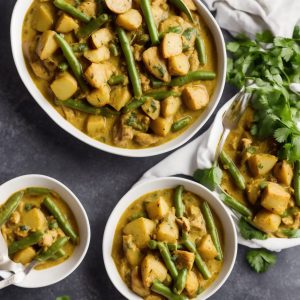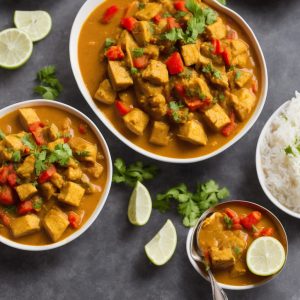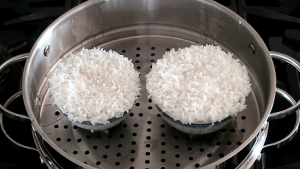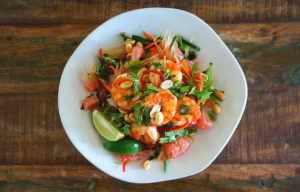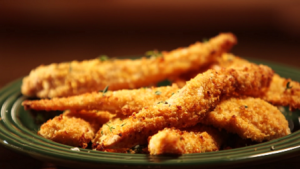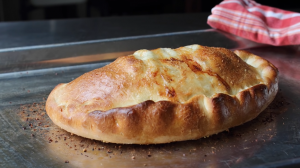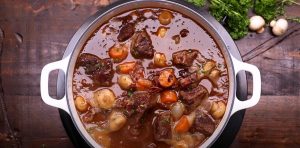This One-Pot Basil Chicken Coconut Curry dish is a flavorful blend of savory and creamy elements. The dish is cooked in one pot, making it easy to prepare and clean up. The fresh basil and coconut milk give it an exotic, tropical flavor, while the curry powder adds a comforting warmth. It's a great meal to impress guests or enjoy as a comforting dinner on a chilly night.
For this dish, you might need to source a few special ingredients. Fresh basil can be found in the produce section of any supermarket, but if you can't find it, dried basil will work in a pinch. Coconut milk is typically found in the international foods aisle. Make sure to get unsweetened coconut milk, not cream of coconut or coconut water. Curry powder is usually in the spice aisle, and there are various types, so you can choose one according to your taste preference.
Essential Ingredients for One-Pot Basil Chicken Coconut Curry
Chicken breasts: These provide the protein base for this dish.
Kosher salt: Enhances the flavors of the other ingredients.
Black pepper: Adds a bit of heat and enhances flavors.
Canola oil: Used for sautéing and also adds a bit of fats.
Red onion: Adds a touch of sweetness and color to the dish.
Jalapeno: Adds heat and a fresh flavor contrast.
Garlic cloves: Provides a savory depth to the dish.
Fresh ginger: Gives a spicy, aromatic and slightly woody flavor.
Fresh basil: Lends an aromatic, sweet-peppery flavor.
Coconut milk: Adds creaminess and a subtle sweetness.
Cornstarch: Used as a thickener.
Curry powder: Gives the dish its characteristic warm, complex flavor.
Cilantro: Used for garnish and adds a bright, citrusy flavor.
One reader, Aurelie Ervin says:





This one-pot basil chicken coconut curry recipe is a game-changer! The flavors are incredible, and it's so easy to make. The combination of basil, coconut milk, and curry powder creates a rich and aromatic sauce that perfectly complements the tender chicken. It's a must-try for anyone who loves delicious, comforting meals.
Key Techniques for Making One-Pot Basil Chicken Coconut Curry
How to sear chicken: Searing chicken involves cooking it over high heat to brown the outside and seal in the juices. This creates a flavorful crust and helps keep the chicken moist.
How to caramelize onions and jalapenos: Caramelizing onions and jalapenos involves cooking them over medium-high heat until they turn golden brown and develop a sweet, rich flavor.
How to thicken sauce with cornstarch: To thicken the sauce, mix the cornstarch with a small amount of cold liquid to create a slurry, then whisk it into the hot liquid. Cook and stir until the sauce thickens.
How to garnish with cilantro: Garnishing with cilantro involves sprinkling fresh cilantro leaves over the finished dish to add a pop of color and a fresh, herbaceous flavor.
How To Make One Pot Basil Chicken Coconut Curry
This no-fuss, chicken coconut curry is made flavorful with mild curry, jalapeno, coconut milk, and basil, for a rich and savory dinner meal!
Serves:
Ingredients
- 1½lbschicken breasts,(4 pieces), boneless, skinless
- ½tspkosher salt
- ¼tspblack pepper
- 2tbspcanola oil,divided
- 1red onion,chopped
- 1jalapeno,de-veined, de-seeded, chopped
- 4garlic cloves,minced
- 1tspfresh ginger,grated
- 3tbspfresh basil,minced
- 13.5ozcoconut milk,(1 can)
- 1tbspcornstarch
- 1tbspcurry powder
- cilantro,for garnish, optional
Instructions
-
Season the chicken breasts with salt and pepper.
-
In a large cast-iron skillet, add 1 tablespoon of canola oil on medium-high heat, and sear the chicken for 3 to 5 minutes on each side until almost cooked through.
-
Remove the chicken from the pan and add in the red onion and jalapenos, along with the second tablespoon of canola oil.
-
Cook on medium-high for about 2 to 3 minutes until slightly caramelized, and the chicken bits from the bottom of the pan have mixed in well with them. Add in the garlic, ginger, basil, and cook for 30 seconds more.
-
Add in the coconut milk, cornstarch and curry powder and whisk together quickly.*
-
Add the chicken back in and cook for an additional 5 to 7 minutes or until the sauce is thick and the chicken is cooked all the way through.
-
Garnish with cilantro, if desired. Enjoy!
Recipe Notes
*This so the cornstarch is absorbed before the coconut milk gets a chance to get hot and clump the cornstarch. Alternative, use a second bowl to mix the coconut milk, cornstarch, and curry first before adding to the pan.
Nutrition
- Calories: 575.70kcal
- Fat: 43.46g
- Saturated Fat: 23.19g
- Trans Fat: 0.21g
- Monounsaturated Fat: 11.95g
- Polyunsaturated Fat: 5.60g
- Carbohydrates: 9.91g
- Fiber: 1.72g
- Sugar: 1.59g
- Protein: 38.35g
- Cholesterol: 108.86mg
- Sodium: 359.28mg
- Calcium: 63.95mg
- Potassium: 696.46mg
- Iron: 4.99mg
- Vitamin A: 58.72µg
- Vitamin C: 9.61mg
Crucial Technique Tip for One-Pot Chicken Curry
When searing the chicken, ensure the pan is hot enough before adding the meat. This will give the chicken a nice, golden-brown crust and lock in the juices. If the pan isn't hot enough, the chicken may stick to the pan and tear when you try to flip it. Also, avoid overcrowding the pan as this can lower the temperature and cause the chicken to steam rather than sear. If necessary, sear the chicken in batches to maintain the right temperature.
Time-Saving Tips for Making This Curry Recipe
Prep ahead: Chop and measure all ingredients before starting to cook to streamline the process.
Use pre-cut chicken: Save time by using pre-cut chicken or leftover cooked chicken.
One-pot cooking: Opt for one-pot recipes to minimize cleanup and save time on dishwashing.
Organize ingredients: Arrange ingredients in the order they are used to avoid searching for items during cooking.
Multi-task: While the chicken is cooking, prep the vegetables to maximize efficiency in the kitchen.
Substitute Ingredients For One Pot Basil Chicken Coconut Curry Recipe
chicken breasts - Substitute with turkey breast: Turkey breast can be used as a lean and flavorful alternative to chicken breast in this recipe, providing a similar texture and taste.
canola oil - Substitute with coconut oil: Coconut oil can add a hint of tropical flavor to the dish and complements the coconut curry, enhancing the overall coconut profile of the recipe.
red onion - Substitute with yellow onion: Yellow onion can be used as a substitute for red onion, providing a slightly milder flavor while still adding a nice depth to the curry.
jalapeno - Substitute with serrano pepper: Serrano pepper can be used as a substitute for jalapeno, offering a similar level of heat and a slightly fruitier flavor.
garlic cloves - Substitute with garlic powder: Garlic powder can be used as a substitute for fresh garlic cloves, providing a convenient alternative while still imparting a delicious garlic flavor to the dish.
fresh basil - Substitute with cilantro: Cilantro can be used as a substitute for basil, adding a fresh and vibrant herbaceous flavor to the curry.
coconut milk - Substitute with almond milk: Almond milk can be used as a substitute for coconut milk, offering a creamy texture and a subtle nutty flavor to the curry.
cornstarch - Substitute with arrowroot powder: Arrowroot powder can be used as a substitute for cornstarch to thicken the curry, providing a similar thickening effect without altering the flavor.
Best Way to Present One-Pot Basil Chicken Coconut Curry
Elevate the plating: When presenting the one-pot basil chicken coconut curry, focus on creating a visually appealing plate. Use clean, white plates to allow the vibrant colors of the dish to pop. Arrange the chicken and curry thoughtfully, ensuring that each element is showcased beautifully.
Garnish with fresh herbs: Add a touch of freshness and color to the dish by garnishing with fresh basil and cilantro. Carefully place the herbs on top of the curry, creating a visually stunning and aromatic presentation.
Incorporate texture: Consider adding a crunchy element to the dish to provide contrast. You can sprinkle toasted coconut flakes over the curry, adding both texture and a delightful nutty flavor.
Utilize negative space: Embrace the concept of negative space on the plate to draw attention to the main components of the dish. Allow the curry to be the focal point, using the empty space on the plate to create a sense of balance and elegance.
Enhance with color: Introduce additional pops of color to the plate by incorporating vibrant elements such as thinly sliced red chili peppers or edible flowers. These colorful accents will elevate the visual appeal of the dish.
Consider the vessel: Select a sophisticated and visually appealing serving vessel to complement the dish. A shallow, wide-rimmed bowl or a modern ceramic plate can enhance the overall presentation and provide a memorable dining experience.
Essential Kitchen Tools for Making Coconut Curry
- Cast-iron skillet: A heavy-duty pan that distributes heat evenly and is great for searing and sautéing.
- Whisk: A kitchen tool used for blending ingredients together and incorporating air into the mixture.
- Tongs: Used for gripping and lifting hot food items, such as turning chicken or stirring ingredients.
- Knife: Essential for cutting and preparing ingredients, such as slicing chicken breasts or chopping vegetables.
- Cutting board: Provides a stable surface for cutting and preparing ingredients, protecting countertops and knives.
- Measuring spoons: Used for accurately measuring small amounts of ingredients, such as salt, pepper, and spices.
- Can opener: Necessary for opening the can of coconut milk.
- Mixing bowl: Used for combining and mixing ingredients together, such as whisking together the coconut milk, cornstarch, and curry powder.
- Spatula: Helps in flipping and turning the chicken while cooking and scraping the skillet to incorporate flavors.
- Garlic press: Useful for quickly and efficiently mincing garlic cloves to add flavor to the dish.
- Grater: Used for grating fresh ginger to infuse the dish with its aromatic flavor.
- Measuring cup: Essential for accurately measuring the coconut milk before adding it to the dish.
Storing and Freezing Homemade Coconut Curry
- Let the one-pot basil chicken coconut curry cool completely before storing it in an airtight container in the refrigerator. It will keep fresh for up to 3-4 days.
- If you want to freeze the curry for later, transfer it to a freezer-safe container or a resealable freezer bag. Make sure to remove as much air as possible before sealing the bag to prevent freezer burn.
- Label the container or bag with the date and contents, so you can easily keep track of when it was frozen.
- The frozen curry can be stored in the freezer for up to 2-3 months.
- When you're ready to enjoy the curry again, thaw it overnight in the refrigerator.
- Reheat the thawed curry in a saucepan over medium heat, stirring occasionally, until it's heated through. You may need to add a splash of coconut milk or water to thin out the sauce if it has thickened too much during storage.
- If you're short on time, you can also reheat the frozen curry directly in a saucepan over low heat, stirring frequently to prevent scorching. It may take a bit longer to heat through, but it will still taste delicious!
How to Reheat Leftover Curry
Reheat the one-pot basil chicken coconut curry in a saucepan over medium-low heat, stirring occasionally, until it reaches the desired temperature. This method helps maintain the original texture and flavor of the dish, allowing the flavors to meld together even more.
If the curry appears too thick after refrigeration, add a splash of coconut milk or water to help thin it out while reheating. Stir well to incorporate the added liquid and ensure a smooth, creamy consistency.
For a quicker reheating method, transfer individual portions of the curry to microwave-safe bowls. Cover the bowls with a damp paper towel to prevent splatters and help retain moisture. Microwave on high for 1-2 minutes, stirring halfway through, or until the curry is heated through.
If you have any leftover rice or naan bread, reheat them separately and serve alongside the warmed curry. To reheat rice, sprinkle a little water over it and microwave in 30-second intervals, stirring between each interval, until heated through. For naan bread, wrap it in foil and place it in a preheated oven at 350°F (175°C) for 5-7 minutes, or until warm and soft.
To add a fresh twist to your leftover curry, garnish it with a handful of freshly chopped cilantro, a squeeze of lime juice, or some thinly sliced red onions. These bright, zesty flavors will help revive the dish and give it a new lease on life.
Interesting Fact About Coconut Curry Recipes
The basil in this recipe adds a fresh and aromatic flavor to the dish, and it also contains essential nutrients such as vitamin K and manganese. These nutrients contribute to bone health and help in the body's natural defense against oxidative stress.
Is Making Basil Chicken Curry at Home Cost-Effective?
This one-pot basil chicken coconut curry recipe is quite cost-effective for a household. The ingredients, such as chicken breasts, coconut milk, and fresh basil, are reasonably priced and readily available. The dish offers a delightful blend of flavors and textures, making it a satisfying and economical choice for a family meal. On a scale of 1-10, I would rate this recipe an 8 for its affordability and delicious outcome. The approximate cost for a household of 4 people is around $20, making it a budget-friendly option for a flavorful and hearty dinner.
Is This Basil Chicken Curry Healthy?
This one-pot basil chicken coconut curry recipe has both healthy and unhealthy aspects. On the positive side, it includes:
- Lean protein from the chicken breasts
- Nutrient-rich vegetables like red onion, jalapeno, garlic, and ginger
- Fresh basil, which is packed with antioxidants and anti-inflammatory properties
- Coconut milk, a source of healthy fats
However, there are some areas of concern:
- The use of canola oil, which is highly processed and may contain harmful compounds
- The high amount of saturated fat from the coconut milk
- The lack of additional vegetables to balance out the dish
To make this recipe healthier, consider the following suggestions:
- Replace the canola oil with a healthier option like coconut oil or avocado oil
- Use light coconut milk instead of full-fat to reduce the saturated fat content
- Add more vegetables to the dish, such as bell peppers, carrots, or spinach, to increase the fiber and nutrient content
- Serve the curry over a bed of brown rice or quinoa for added whole grains and fiber
- Reduce the amount of cornstarch used to thicken the sauce, as it is a refined carbohydrate
- Experiment with using Greek yogurt in place of some of the coconut milk for a protein boost and reduced fat content
By making these adjustments, you can transform this delicious one-pot meal into a more balanced and nutritious dish that still satisfies your taste buds.
Editor's Opinion on This Basil Chicken Coconut Curry
This one-pot basil chicken coconut curry recipe is a delightful fusion of flavors and textures. The combination of tender chicken, aromatic basil, and creamy coconut milk creates a harmonious balance. The use of fresh ingredients like ginger and jalapeno adds a vibrant kick, while the curry powder infuses depth and warmth. The method of searing the chicken before simmering it in the coconut curry ensures a succulent and flavorful result. Overall, this recipe offers a delightful and aromatic dish that is sure to impress with its rich and complex flavors.
Enhance Your One Pot Basil Chicken Coconut Curry Recipe with These Unique Side Dishes:
Similar Recipes to Try If You Love This Curry
Appetizer and Dessert Pairings for One-Pot Curry
Why trust this One Pot Basil Chicken Coconut Curry Recipe:
This recipe offers a delightful fusion of flavors, combining succulent chicken breasts with aromatic basil and rich coconut milk. The use of fresh ingredients such as garlic and ginger ensures a vibrant and authentic taste. The method of searing the chicken and caramelizing the onion and jalapeno creates a depth of flavor that will surely impress. With the addition of curry powder and a touch of cilantro for garnish, this one-pot dish promises a satisfying and aromatic experience for all food enthusiasts.
Was this page helpful?
Have your own special recipe to share? Submit Your Recipe Today!

